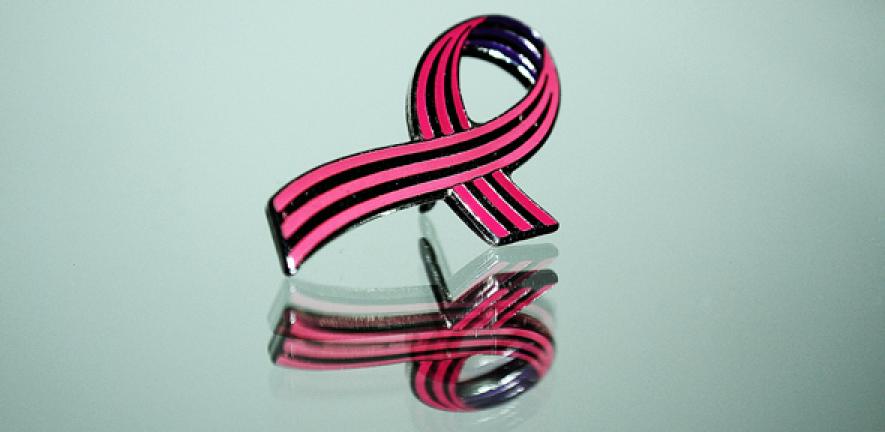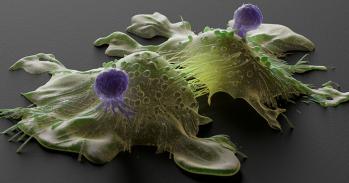
An international study of almost 120,000 women has newly identified five genetic variants affecting risk of breast cancer, all of which are believed to influence how breast cells respond to the female sex hormone oestrogen.
An international study of almost 120,000 women has newly identified five genetic variants affecting risk of breast cancer, all of which are believed to influence how breast cells respond to the female sex hormone oestrogen.
There may be a ‘Goldilocks’ level of oestrogen receptors in breast cells: too few or too many and the breast cells are more likely to become cancerous
Alison Dunning
Breast cancer is the most common type of cancer among women. Around one in eight women in the general population is expected to develop the disease at some point in her life. The majority of cases occur in women aged 50 and over.
The female sex hormone oestrogen acts as a trigger, binding to a molecule known as an oestrogen receptor in most breast cells and triggering a cascade of signals that cause the cell to behave normally. However, the oestrogen receptor is switched off in some cells and these do not respond to the hormone.
An international collaboration, led by researchers at the University of Cambridge and the QIMR Berghofer Medical Research Institute, examined the DNA surrounding the gene for the oestrogen receptor – known as ESR1 – in women with different types of breast cancer against those of healthy controls to identify genetic variants responsible for an increased risk of breast cancer. The results are published today in the journal Nature Genetics.
Among their findings, the researchers discovered five cancer-risk variants based within or around the ESR1 gene. This gene has long been known to be related to the risk and progress of breast cancer, but little is understood of how it works and why it should affect breast cancer.
Of the five variants discovered by the team, four were more strongly associated with tumours where the ESR1 gene is switched off, so the tumour cells have no oestrogen receptors. These represent around one fifth of breast cancers.
One of these four variants was of particular interest as it was associated with a rarer type of breast tumour that contain active receptors for the protein known as ‘human epidermal growth factor 2’ (HER2). Such tumours can be treated by the drug trastuzumab (marketed as Herceptin). This is believed to be the first time a specific genetic risk factor for HER2 positive breast tumours has been found.
Dr Stacey Edwards’ team from QIMR Berghofer, Brisbane, had been searching for gene regulatory elements around the ESR1 gene, which act like the volume controls on a radio or TV, turning the activity of the nearby genes up or down. There are two major types of gene regulators: ‘enhancers’, which increase activity of the genes express such that they make more protein, and ‘silencers’, which have the opposite effect.
When the Cambridge and Brisbane teams compared notes, they spotted that four of the breast cancer risk variants coincided with ‘volume-up’ enhancers. These particular regulators did not just affect the ESR1 gene but also other nearby genes. The variants that increased risk of breast cancer directly reduced the effectiveness of each enhancer, hence turning down the volume of ESR1 and the other nearby genes. This reduced the amount of oestrogen receptor produced by breast cells.
The researchers say that their results suggest the ESR1 gene works with other nearby genes to affect breast cancer development.
The fifth genetic variant was found to be more strongly associated with tumours where the oestrogen receptor is switched on. This variant coincides with and alters the effectiveness of ‘volume-down’ silencer, which means that it increases the amount of oestrogen receptor protein produced by breast cells.
“It’s interesting that all five of the genetic variants that we have found affect levels of oestrogen receptors in breast cells,” says Dr Alison Dunning from the Department of Oncology at the University of Cambridge, one of the lead authors on the study. “This suggests that there may be a ‘Goldilocks’ level of these receptors in breast cells: too few or too many and the breast cells are more likely to become cancerous.”
“As our research looks at how tumours with and without the oestrogen receptor are regulated, it’s possible it could help make sense of the enduring mystery of how tamoxifen works and why tumours develop in these two divergent ways,” says Dr Edwards, one of the study’s senior authors. “Our findings could open the way to developing new, more specific breast cancer preventions.”
The genetic variants are all very common, each one carried by around one in three women. Each variant only increases the risk of developing breast cancer by a small amount.
Professor Doug Easton, another senior author from the University of Cambridge, adds: “breast cancer is a very complex disease, with many genes, and other factors, contributing to an overall increased risk of developing the disease. These five common variants that we have identified will contribute to an eventual predictive test for breast cancer risk, and for determining the risk of the particular subtype of breast cancer, that will include hundreds of similar variants.”
Funding for the study came from organisations including the European Union, Cancer Research UK, the National Health and Medical Research Council of Australia and the Australian National Breast Cancer Foundation.
Dr Alan Worsley, Cancer Research UK’s senior science information officer, said: “We know that hundreds of genes are likely to play a role in how cancers start. And this latest study adds more detail to our genetic map of breast cancer risk, potentially helping understand which type of breast cancer is likely to develop based on a woman’s genetic makeup. Understanding more about each individual’s risk of cancer could help us find ways to potentially prevent the disease or pick it up in its earliest stages."
Reference
Dunning, AM et al. Breast cancer risk variants at 6q25 display different phenotype associations and regulate ESR1. RMND1 and CCDC170. Nature Genetics; published online 29 Feb 2016. DOI: 10.1038/ng.3521.

The text in this work is licensed under a Creative Commons Attribution 4.0 International License. For image use please see separate credits above.




